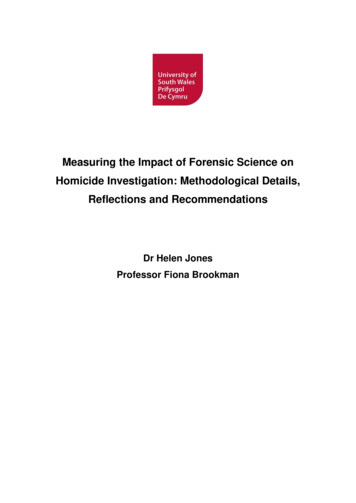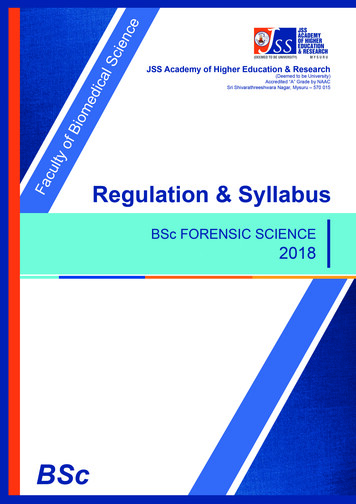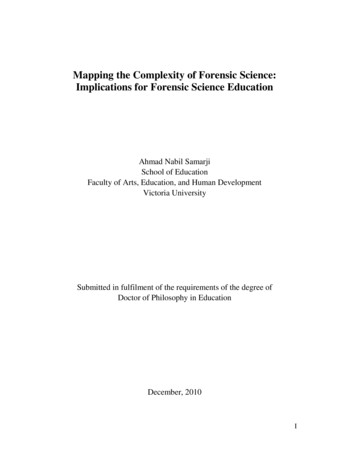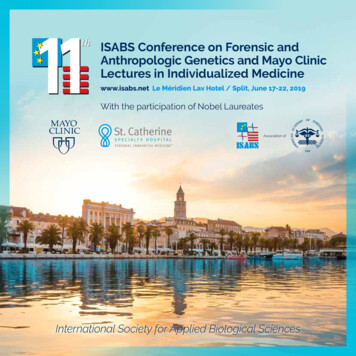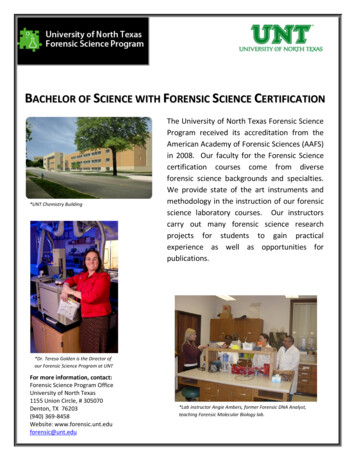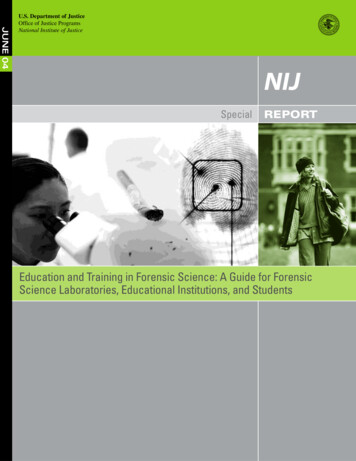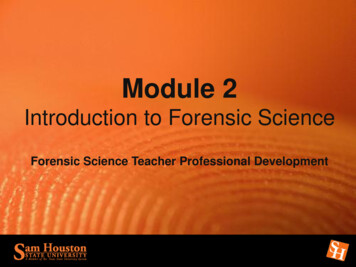
Transcription
Module 2Introduction to Forensic ScienceForensic Science Teacher Professional Development
OverviewModule 2A-Unit 1: Introduction to Forensic Science1. What is Forensic Science?2. History and Development of Forensic Science3. What is Forensic Evidence?4. Introduction to Forensic Science Evidence Types and Specialties5. Introduction to Laboratory Examination of Forensic EvidenceModule 2B-Unit 2: Forensic Science Ethics6. What is Ethics?7. Personal Ethics8. Ethics in Criminal Justice9. Scientific Ethics10. Crime Scene and Forensic Laboratory Ethics11. Courtroom Ethics12. Ethics Enforcement13. Professional Organization Codes of Ethics and ConductModule 2C-Unit 3: Forensic Science Legal Aspects14. Introduction to Forensic Evidence in the Criminal Justice System15. Expert Witness Testimony16. Admissibility of Behavioral, Scientific, and Technical Evidence
Module 2AIntroduction to Forensic ScienceForensic Science Teacher Professional Development
Unit 1.1: What is Forensic Science?Forensic science is science which is applied tothe criminal and civil laws enforced byagencies in the criminal justice system. Manydifferent professions are included under theterm forensic science.
Unit 1.1: What is Forensic Science?The American Academy of Forensic Sciences (AAFS)The membership of AAFS is divided into eleven sections which include stsPhysical anthropologistsDocument stsEducatorsDigital evidence expertsAnd othersMembers are in all 50 U.S. states, Canada, and 61 other countries.AAFS allows professionals to keep up to date on research and newtechniques while helping inform the public about the profession.Follow this link to the AAFS Website and review the material itcontains: http://www.aafs.org/
Unit 1.1: What is Forensic Science?For purposes of this course, the terms “forensicscience” and “forensic scientist” will be used.Forensic science is often interchangeable withCriminalistics.Criminalistics is often used to describe theservices of a crime laboratory.Forensic laboratory personnel may be referred toas criminalists.A criminalist is generally involved in thelaboratory analysis of forensic evidence.
Unit 1.2: History & Development ofForensic ScienceReview the following history of forensics timelineprovided by the American College of ine.htmlThe DNA Initiative has a section which discusses thehistory of forensic DNA analysis. The organizationprovides funding, training, and technical assistance toadvance criminal justice through DNA technology.
Unit 1.3: What is Forensic Evidence?Forensic evidence is simply information. Evidence is necessary to prove the body of the crime, knownas the corpus delecti. Evidence is analyzed to identify the physical or chemicalproperties of a substance and provide comparisons betweena suspect specimen and a known standard. After analysis, the forensic scientist must render a conclusionabout the evidence to show individual or classcharacteristics. Individual characteristics are properties that can be attributedto a common source with a high degree of certainty. Class characteristics are properties of evidence that can onlybe associated with a group and not tied individually to asingle source.
Unit 1.3: What is Forensic Evidence? Real evidence is sometimes called physical evidence; it isrelevant and material to the crime and usually can beproduced in court. Demonstrative evidence demonstrates or illustrates thetestimony of a witness. Examples are maps, diagrams ofthe scene of an occurrence, and animations. Documentary evidence is a kind of real evidenceassociated with human language. Direct evidence is testimonial evidence of witnesses thatties the offender to the crime. Circumstantial evidence is based not on personalknowledge, but rather an inference.
Unit 1.3: What is Forensic Evidence? Conclusive evidence is strong enough to counter otherevidence to the contrary. Corroborating evidence may differ from other evidence, butstrengthens other evidence. Derivative evidence is obtained illegally and inadmissiblebecause of the fruit of the poisonous tree doctrine. Exculpatory evidence can establish the innocence of adefendant. Foundational evidence is evidence that is admitted to provethe foundation of other admissible testimony. Hearsay evidence is evidence that a witness has no directknowledge of and must be proven by another source.
Unit 1.3: What is Forensic Evidence? Incriminating evidence establishes guilt of a party. Presumptive evidence is considered true and sufficientunless challenged by another party. Prima facie evidence establishes a fact unless othercontradictory evidence is presented. Probative evidence can disprove or prove a point ofcontention. Rebuttal evidence is offered to contradict or disproveevidence presented by the other side. Tainted evidence is evidence that is inadmissible becauseit was obtained by illegal means.
Unit 1.4: Introduction to ForensicScience Evidence Types & SpecialtiesLocard’s Exchange Principle: Is named after a French police officer States that whenever two objects come intocontact, trace materials are exchanged betweenthe two Can be applied to any object at a crime scene,such as biological evidence, trace amounts offibers, and prints, including but not limited tofingerprints, tire impressions, and tire tracks Exchange occurs even if the material is toomicroscopic to be detected. Once trace material isdiscovered in an investigation, it may be used toprovide valuable information that can assistinvestigators in locating the perpetrator of a crime.The material exchange is demonstrated by evidence.
Unit 1.4: Introduction to ForensicScience Evidence Types & SpecialtiesBloodstain Pattern AnalysisBloodstain pattern analysis is the study of the movementand direction of objects or persons while bleeding.Bloodstain pattern analysis examines the direction of theorigin of the blood, the angle at which the blood falls ona surface, the location and position of victims whilebleeding, the movement of the individual bleeding, andthe location of the individual producing the injury.http://www.swgstain.org/
Unit 1.4: Introduction to ForensicScience Evidence Types & SpecialtiesCadaver Dog HandlerCadaver dogs are trained to detect the scent ofdecomposition of human remains and are used toconduct searches on land and in water for remains.http://www.cadaverdog.com/
Unit 1.4: Introduction to ForensicScience Evidence Types & SpecialtiesCrime Scene ReconstructionCrime scene reconstruction uses investigation andscientific techniques to determine the sequence ofevents before, during, and after a crime.Reconstructions are based on data collected at thescene and hypotheses formed as a result of theinformation gathering process.http://www.acsr.org/
Unit 1.4: Introduction to ForensicScience Evidence Types & SpecialtiesDigital ForensicsDigital forensics involves the forensic detection andrecovery of digital evidence at a crime scene. Digitalforensic professions are involved with the seizure,digital imaging, analysis, and reporting results of digitalmedia ion.org/
Unit 1.4: Introduction to ForensicScience Evidence Types & SpecialtiesDNAForensic DNA analysis can link a suspect to a crime oreliminate a suspect. Each individual’s DNA profile isunique. DNA samples can be obtained from blood, bone,hair, and other body tissues and e/dna/basics/welcome.htm
Unit 1.4: Introduction to ForensicScience Evidence Types & SpecialtiesFirearms and Tool Mark ExaminationA tool mark is an impression or scrape that is left behindwhen a harder object (the tool) is pressed or moved acrossa softer surface. Tool mark examinations are usuallyconducted by analysts in a firearms lab.As with tools, the manufacturing process of many firearmsresults in the unique characteristics of the weapon.As with tool marks, marks made by firearms can beclassified as individual and class gun.org/
Unit 1.4: Introduction to ForensicScience Evidence Types & SpecialtiesForensic AccountingForensic accounting is the study and interpretation ofevidence relating to accounting practices. Forensicaccountants apply accounting, auditing, andinvestigative skills to assist in investigations andprovide litigation support.http://www.nafanet.com/
Unit 1.4: Introduction to ForensicScience Evidence Types & SpecialtiesForensic AnthropologyForensic anthropologists examine skeletal,decomposed, or otherwise unidentified human remains.Forensic anthropologists also assess the age, sex,ancestry, stature, and unique features of the deceasedfrom skeletal remains.http://www.theabfa.org/
Unit 1.4: Introduction to ForensicScience Evidence Types & SpecialtiesForensic ArtForensic artists combine art with science to furtherjustice. Forensic artists may draw suspect composites,perform facial reconstruction, and compile crime scenecharts and graphs. Some forensic artists also usecomputer animation to assist with their ications/artist/index.php
Unit 1.4: Introduction to ForensicScience Evidence Types & SpecialtiesForensic BotanyForensic botanists apply the study of botany to law.Because botanical plant evidence exists in almost alllocations and has a diverse morphology, plant remainscan be used to solve crimes by linking offenders tolocation and or victims. Pollen can provide informationon the time of year or how long an evidence item wasexposed to elements. Pollen from plants also hascharacteristic shapes that can be associated to aparticular -botany-a269255
Unit 1.4: Introduction to ForensicScience Evidence Types & SpecialtiesForensic EngineeringForensic engineers apply engineering in thejurisprudence setting. Many types of engineeringdisciplines are represented in the profession.http://www.nafe.org/
Unit 1.4: Introduction to ForensicScience Evidence Types & SpecialtiesForensic EntomologyForensic entomology is the science of using informationgained from insects and arthropods in investigation.Often, medico-legal entomology is used in time of deathdetermination. However, entomology has also beenused in child and elder abuse cases to show neglect andlack of proper care of wounds and in accidentreconstruction. Entomology is used in urban settings incases in which pesticides or treatments may be at issue.Stored-product entomology is also used to examine buginfestation or contamination in commercially distributedfood.http://www.forensicentomology.com/
Unit 1.4: Introduction to ForensicScience Evidence Types & SpecialtiesForensic Fiber AnalysisFibers found at a crime scene can be used to link anoffender to the crime scene and/or a victim. Fiberscan be transferred by direct or indirect contact. Fiberscan be both natural and synthetic.http://www.astm.org/Standards/E2224.htm
Unit 1.4: Introduction to ForensicScience Evidence Types & SpecialtiesForensic Fingerprint AnalysisFingerprints are defined as imprints deposited on a surface by thefriction ridges on a fingertip.Three different types of fingerprints found at crime scenes:1) Latent prints: A latent print is defined as an impression that is notreadily visible to the naked eye and requires further developing toenhance the details. Latent prints are the most common type offingerprints found at crime scenes.2) Patent (or visible) prints: Patent prints are fingerprintimpressions that are visible due to the medium in which theimpression is made. Some common mediums are dirt, grease, blood,or dust. Patent prints do not usually require further developing butmay require additional visualization techniques.3) Plastic (or impression) prints: Plastic prints are recognizablefingerprints made by pressing on a soft receiving surface that willretain a three-dimensional representation of the friction ridge tml
Unit 1.4: Introduction to ForensicScience Evidence Types & SpecialtiesForensic Fire and Arson InvestigationForensic fire and arson investigators examine fire-relatedincidents.Investigators should determine the origin and cause of the fire orexplosion in question, examine the physical attributes of a fire scene,and identify and collect physical evidence from thescene.The evidence collected is analyzed to help determine ifthe cause of the fire was accidental or deliberate.
Unit 1.4: Introduction to ForensicScience Evidence Types & SpecialtiesForensic Glass AnalysisGlass is composed of the primary chemical componentsof sand, lime, and washing soda. Most bottle and windowglass is composed of soda lime. Other types of glasshave additions. Some types of glass are tempered forsafety such as automobile glass that is designed todisintegrate on impact. Most glass evidence cannot beindividualized, but physical matches can rensic%20Glass%20Examination.pdf
Unit 1.4: Introduction to ForensicScience Evidence Types & SpecialtiesForensic Hair AnalysisHair analysis examines the cuticle, cortex and medulla ofhair. Each of the three forensic races, Caucasoid,Negroid, and Mongoloid, have different hair features. Hairevidence cannot be individualized by microscopicexamination. DNA analysis is only available if the root ofthe hair is intact. Nuclear DNA can be found in hair rootsheath cells, but only mitochondrial DNA is found in thehair r%20Examination%20Guidelines.pdf
Unit 1.4: Introduction to ForensicScience Evidence Types & SpecialtiesForensic LinguistForensic linguistics can be fairly characterized as theapplication of linguistic knowledge, methods, andinsight to the forensic context of law, investigation, trial,punishment, and rehabilitation. Forensic linguistsexamine contexts within the written law, and examinelanguage use in forensic and judicial uk/forensic/IAFL/
Unit 1.4: Introduction to ForensicScience Evidence Types & SpecialtiesForensic NursingA forensic nurse is a nurse that provides specialized carefor patients, both victims and perpetrators of violence.They care for the physical, psychological, and socialtrauma that occurs in patients who have been assaulted orabused. Forensic nurses also have a specializedknowledge of the legal system and collect evidence,provide medical testimony in court, and provideconsultation to legal authorities.http://www.forensicnurses.org/
Unit 1.4: Introduction to ForensicScience Evidence Types & SpecialtiesForensic OdontologyForensic odontology is the examination and evaluationof dental evidence. Forensic odontologists, or forensicdentists, help identify human remains through dentalrecords and comparisons, assess bite marks, and canhelp with age determination.http://www.abfo.org/http://asfo.org/
Unit 1.4: Introduction to ForensicScience Evidence Types & SpecialtiesForensic Paint AnalysisPaint analysis is a type of trace analysis. Paints are defined aspigments carried within a suitable vehicle with minor amounts ofadditives such as driers, surfactants, etc., which when dry form acolored film over a surface. The vehicle portion of paint forms thefilm while the pigments provide color, opacity, and bulk to the film.Pigments can be distinguished from dyes, since unlike dyes, theyare insoluble in the vehicle in which they are mixed. From aforensic analysis viewpoint, paint usually occurs as chips or flakes,but can occur in powder form.http://www.astm.org/Standards/E1610.htm
Unit 1.4: Introduction to ForensicScience Evidence Types & SpecialtiesForensic PathologyForensic pathologists are medical doctors whospecialize in forensic pathology. They perform autopsiesand determine the manner and cause of death.Forensic pathologists examine and document wounds,collect toxicology samples, and collect other tissuesamples to determine manner and cause of death.
Unit 1.4: Introduction to ForensicScience Evidence Types & SpecialtiesForensic PhotographyForensic photographers are responsible for recordingthe crime scene through photographic methods. Thisprocess is a vital recording of the crime scene. Modernforensic photographers use both 35 mm film and digitalphotography to capture the /
Unit 1.4: Introduction to ForensicScience Evidence Types & SpecialtiesForensic Psychiatry and PsychologyForensic psychiatrists and psychologists applypsychiatry in the legal process. Forensic psychiatristsare often used to determine a defendant’s competencyto stand trial. Forensic psychologists are trained inclinical, social, organizational, or other branches ofpsychology and also operate within a legal setting.Often forensic psychologists determine sentencing andtreatment recommendations for offenders. Forensicpsychologists may also evaluate police personnel andwork with both public defenders and state attorneys.http://www.nationalafc.com/
Unit 1.4: Introduction to ForensicScience Evidence Types & SpecialtiesForensic Social WorkForensic social work is the application of social work toquestions and issues relating to law and legal systems.The broader definition of forensic social work includessocial work practice and how it is related to legal issuesand litigation. Forensic social workers may becomeinvolved in child custody issues and other familysituations which may include separation, divorce,neglect, termination of parental rights, the implicationsof child and spouse abuse, juvenile and adult justiceservices, corrections, and mandated treatment.http://www.nofsw.org/
Unit 1.4: Introduction to ForensicScience Evidence Types & SpecialtiesForensic Soil AnalysisSoil scientists, or pedologists, examine soil which iscomposed of minerals from weathered rocks,decomposed biological material, and other man-madematerials. Soil evidence can be useful for comparisonsor contain impressions of shoe or tire imprints.
Unit 1.4: Introduction to ForensicScience Evidence Types & SpecialtiesForensic ToxicologyForensic toxicology encompasses other disciplinessuch as analytical chemistry, pharmacology, andclinical chemistry to assist medical or legalinvestigation of death, poisoning, and drug use.http://www.abft.org/http://www.soft-tox.org/
Unit 1.4: Introduction to ForensicScience Evidence Types & SpecialtiesQuestioned DocumentsThe discipline of questioned documents relates to anyforensic analysis of a document which may be in disputein court. This specialty includes handwritingexaminations.http://www.asqde.org/
Unit 1.5: Introduction to LaboratoryExamination of Forensic Evidence Physical evidence is used to identify physicalor chemical properties of a substance to link anoffender to the crime scene. The identification process involves scientifictesting in the forensic laboratory according toestablished procedures. The scientific testing should exclude othersubstances for the identification. In addition, scientific comparison is performedin the forensic laboratory, which may comparea suspect piece of evidence with a knownstandard.
Unit 1.5: Introduction to LaboratoryExamination of Forensic Evidence After examination, the forensic scientist forms aconclusion about the evidence. Forensic scientists in the laboratory associateevidence to a particular class of characteristics,and if possible, provide proof that evidence hasindividual characteristics. The examination in the laboratory cancorroborate events of a crime which have beenhypothesized by an investigator. Often, it is a determination in court that showsthe evidence is useful for individualizationrather than a class determination.
End of Module 2AForensic Science Teacher Professional Development
Unit 1.1: What is Forensic Science? For purposes of this course, the terms "forensic science" and "forensic scientist" will be used. Forensic science is often interchangeable with Criminalistics. Criminalistics is often used to describe the services of a crime laboratory. Forensic laboratory personnel may be referred to as criminalists.
